Vol. 68, No. 21 (2019)
2019-11-05
ELECTROMAGNETISM, OPTICS, ACOUSTICS, HEAT TRANSFER, CLASSICAL MECHANICS, AND FLUID DYNAMICS

2019, 68 (21): 214201.
doi: 10.7498/aps.68.20190847
Abstract +
Isolated attosecond pulses make it possible to study and control the ultrafast electron processes in atoms and molecules. High order harmonic generation (HHG) is the most promising way to generate such pulses, benefiting from the broad plateau structure of the typical HHG spectrum. In previous HHG studies on the polarization gating scheme, atomic ionization caused by the laser cycles before the polarization gate not only places a limit on the pulse width and intensity of the driving laser, but also affects the phase matching of harmonics generated in a polarization gate. According to these, in this paper we propose a new double optical gating scheme, in which the polarization of the laser pulse changes from linear to elliptical and back to linear again. Thus, only the linearly polarized field in the leading of the pulse contributes to high harmonic generation. By using a strong field approximation theory, we first simulate high order harmonic and attosecond pulse generation from helium atom irradiated by a double optical gating pulse based on the orthogonal polarization field. Here the orthogonal polarization field consists of two linearly polarized pulses with a certain time delay, orthogonal polarization directions and equal amplitudes. And for the double optical gating pulse, the second harmonic of the driving field is added to an orthogonal polarization field with an appropriate phase and energy. It is found that the high harmonic spectrum with higher efficiency and supercontinuum plateau is obtained by reasonably adjusting the parameters of the combined pulse. After inverse Fourier transform, an isolated 143-as pulse with higher intensity can be realized by superposing supercontinuum harmonics from the 50th to the 150th order. Compared with the double optical gating scheme proposed by Chang et al. (Zhao K, Zhang Q, Chini M, Wu Y, Wang X, Chang Z 2012 Opt. Lett. 37 3891), our scheme not only overcomes the limit on the pulse duration and intensity of the incident pulse laser, but also avoids the harmonic phase mismatching in the process of the propagation due to unwanted ionization of the gas target caused by the laser cycles before the polarization gate.
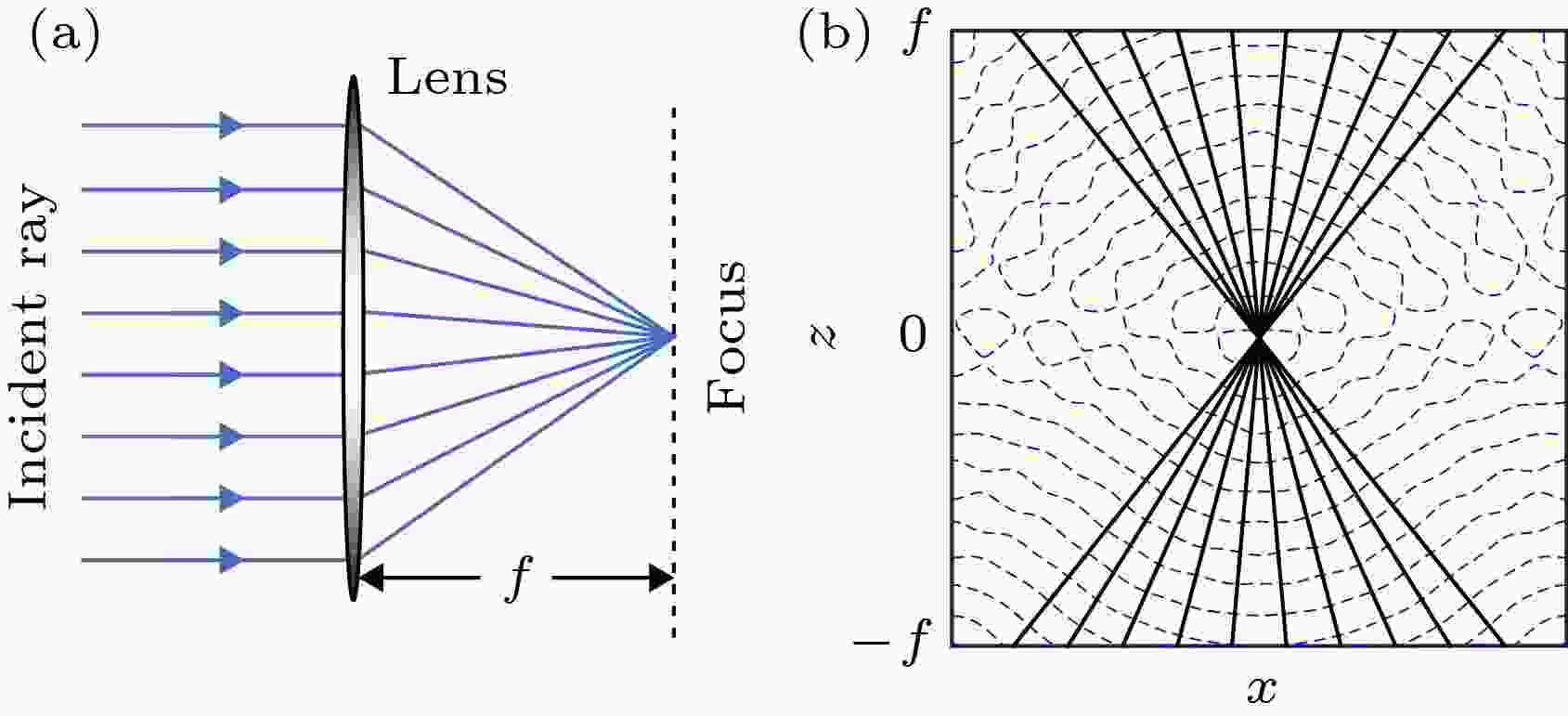
2019, 68 (21): 214202.
doi: 10.7498/aps.68.20190839
Abstract +
Establishing a universal model to characterize the relationship between light rays and optical waves is of great significance in optics. The ray model provides us with an intuitive way to study the propagation of beams as well as their interaction between objects. Traditional ray model is based on the normal of a beam wave front. The normal vector is defined as the direction of ray. However, it fails to describe the relationship between light ray and optical wave in the neighborhood of focus or caustic lines/surface since light ray in those regions are no longer perpendicular to the wavefront. In this work, the ray model of a light beam is built according to its Fourier angular spectrum, where the positions of rays can be determined by the gradient of the phase of the Fourier angular spectrum. On the other hand, the Fourier angular spectrum of a light beam can be reconstructed through the ray model. Using Fourier angular spectra, we construct the ray model of two typical beams including the Airy beam and the Cusp beam. It is hard to construct ray model directly from the optical field of these beams. In this ray model, the information about ray including direction and position involves the propagation properties of light beams such as self-accelerating. In addition, we demonstrate that the optical field of the focused plane wave can be reconstructed by the ray model in Fourier regime, and the optical field in spatial domain can be obtained by inverse Fourier transform. Simulation results are consistent with the results from Debye’s method. Finally, the high-dimensional ray model of light beams is elaborated in both spatial and spectral regime. Combined with focused plane wave, Airy beam and rays in quadratic gradient-index waveguide, our results show that the ray model actually carries the information about optical field in both spatial and Fourier domain. Actually, the traditional ray model is just a spatial projection of the high-dimensional ray model. Hence, when traditional ray model fails at the focus or caustic lines/surface, it is able to obtain the spectrum of the corresponding optical field from the Fourier domain, and then obtain the field distribution in spatial domain by inverse Fourier transform.

2019, 68 (21): 214203.
doi: 10.7498/aps.68.20190862
Abstract +
In order to improve the efficiency of wireless power transfer (WPT) system, the spatial fields are regulated on a two-non-resonant-coil WPT system by hexagon artificial magnetic conductors (AMC). In our configuration, the AMC is located by the side of the two-non-resonant-coil WPT system and close to the transmitter coil. The AMC structure consists of small hexagon copper patches periodically arranged on the dielectric substrate. Each patch is grounded by a via passing through its center hole. Chip capacitors are soldered in the gaps between the adjacent patches. We can design the working frequency of WPT system through the capacitance of these chip capacitors. The results show that the electromagnetic fields are changed between the transmitter coil and the receiver coil in WPT system due to the introducing of the AMC structure. There are two main reasons. First, many resonant modes are excited by near magnetic fields on the AMC structure. Second, near magnetic fields are shielded by the AMC structure. The variation of space electromagnetic field improves the transmission efficiency of WPT system. When the working frequency is 27 MHz and the transmission distance is 3 cm, the experiment verifies that the transmission efficiency increases by 22% in the WPT system with the AMC structure compared with the WPT system without the AMC structure. Simultaneously, the transmission efficiency is raised by 25% at different transmission distances. The simulation results are almost consistent with the experimental results. There is a little difference that the number of resonant modes is different between the simulation and the experiment due to the resistance loss of the chip capacitors in experiment. Therefore, we correct the simulation results under consideration of resistive loss. In addition, the excited multiple resonant modes can supply multiple and adjustable working frequencies in the WPT system with the AMC structure. In practical applications, AMC is low in cost and easy to implement.

2019, 68 (21): 214204.
doi: 10.7498/aps.68.20191164
Abstract +
With the unveiling of molecular and atomic dynamics, scientists crave finer and faster tools to communicate with the microworld. Attosecond pump-probe enjoys its reputation as the fastest camera, hinting ultrafast movements in the delay graph. To employ this camera, the stability and delay control should have very great accuracy comparable to the camera resolution. It is also of significant importance for stabilizing the carrier envelope phase (CEP) in few-cycle laser field. When dealing with a huge quantity of data, conventional Fourier transform algorism is challenging in high-speed control. Here we put forward the efficient calculation method, fast Fourier transform (FFT) algorism in Mach-Zehnder interferometer for arm length locking and f-2f for CEP locking. In the interferometer locking, 532 nm continuous wave laser is used in the Mach-Zehnder interferometer, and the phase of the FFT term corresponding to the delay between the two arms of the interferometer serves as a feedback signal on piezo transducer (PZT) in the delay line to reduce the change of the arm length. In the CEP control experiment, data to be analyzed are the f-2f spectrum interference fringes recorded by the spectrometer. The CEP values are obtained from the first order of FFT module output of the integrated spectrum interference fringes, and a labview program examines the relative phase drift and sends a feedback voltage signal to the PZT through the proportion integration differentiation module to compensate slow CEP drift after the chirped pulse amplification system by changing the insert length of a prism pair. The results show that the root mean square (RMS) of the arm length difference is 1.24 nm (4.1 attosecond for light to travel) per meter in the interferometer locking over 12 h, and the RMS of CEP is 227 mrad under 3 ms integration time in the CEP locking over 20 min. These results are able to meet the requirement of the accuracy for attosecond pulse generation and attosecond pump-probe experiments. We also use FFT to stabilize the CEP and relative time simultaneously in the waveform synthesis for 8 h (Huang P, Fang S, Gao Y, Zhao K, Hou X, Wei Z 2019 Appl. Phys. Lett. 115 031102), the phase-locking system results in a CEP stability of 280 mrad and a relative time stability of 110 as at a repetition rate of 1 kHz. These results imply that the FFT is versatile and reliable in ultrafast control.

EDITOR'S SUGGESTION
2019, 68 (21): 214205.
doi: 10.7498/aps.68.20190837
Abstract +
In this paper, we study the second harmonic generation (SHG) from the stero-stacked meta-molecules consisting of two vertically stacked split ring resonators (SRRs) that resonate at the fundamental wavelength. When pumped by the linearly polarized incident wave with the electric field direction along one of the SRRs’ arms, the meta-molecules emit the SHG that can have two non-zero orthogonal electric field components, provided that the top SRR and the bottom SRR are not arranged in mutually parallel or anti-parallel manner. Due to the strong coupling between the two SRRs, the plasmonic properties of the stero-stacked meta-molecules could be tuned by varying the twist angle between the two SRRs. In this process, we demonstrate that the amplitudes of the two orthogonal SHG field components, and the phase difference between these two components can be varied with changing the twist angle between two SRRs. Based on the concept of the light polarization, different polarization states can be achieved by changing the differences in phase and amplitude between the orthogonal field components. Therefore, the twist angle dependent amplitudes of and phase difference between two orthogonal SHG field components can be used to manipulate the polarization states of the emitted SHG. For the stero-stacked meta-molecules with a fixed twist angle of 60°, elliptically, near-circularly andnear-linearly polarized SHG emission can be obtained at different fundamental wavelengths. In addition, for the fundamental wave with a fixed wavelength of 1500 nm, the stero-stacked meta-molecules with different twist angles are demonstrated to be able to emit SHG with elliptical andnear-linear polarization states.
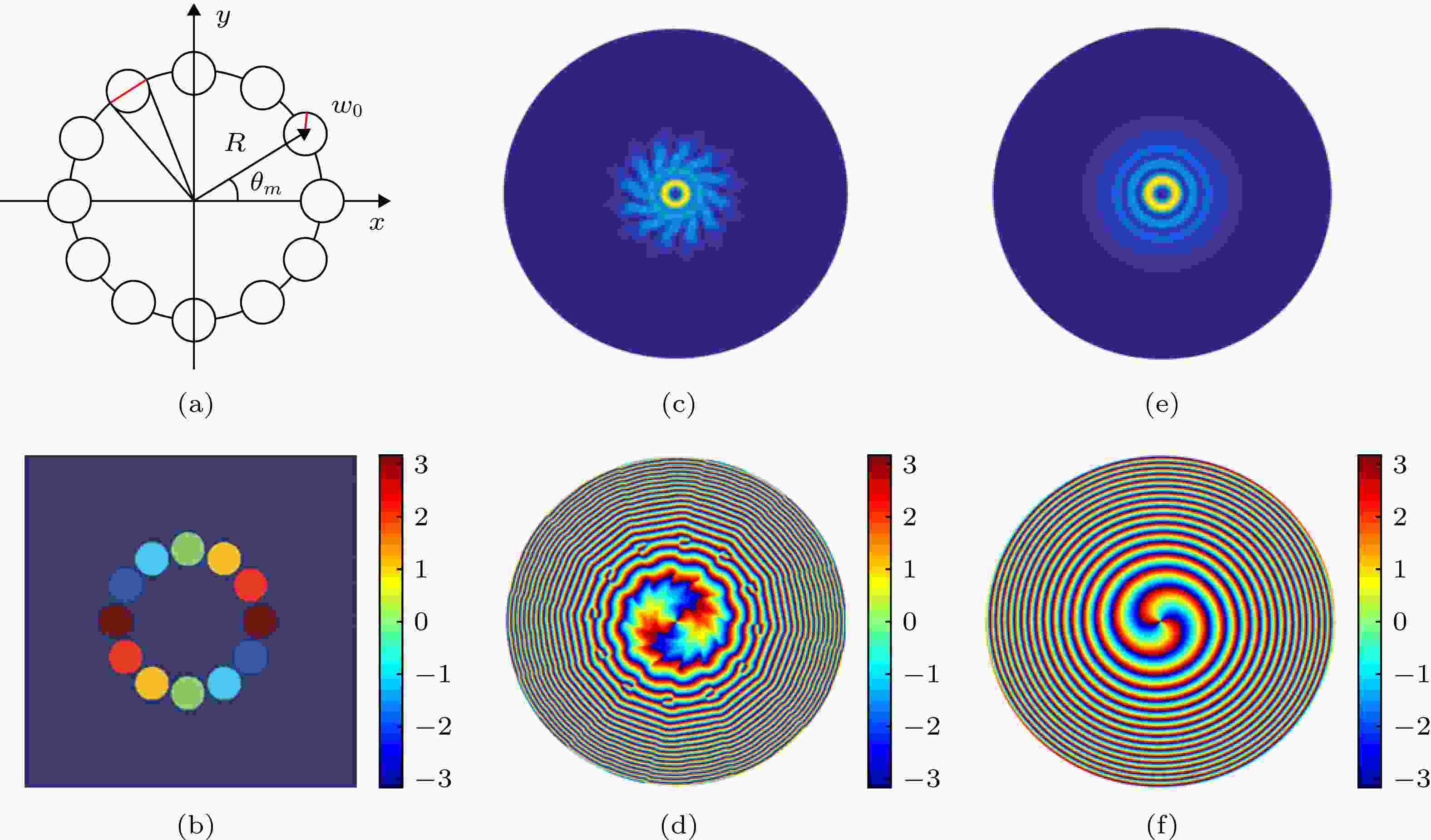
2019, 68 (21): 214206.
doi: 10.7498/aps.68.20190880
Abstract +
The vortex beam is a ring-shaped beam whose center intensity or axial intensity is zero in the propagation direction and whose phase has a spiral rising or falling gradient distribution, which is also called a dark hollow beam. Vortex beams have important applications in free-space optical communication, optical micromanipulation, quantum information processing, optical measurement, super-resolution imaging, laser processing, and material processing. In recent years, with the in-depth research on vortex beams, the application requirements for high-power vortex beams also increase. High-power and high-quality vortex beam can be obtained by coherent combining technology. However, the spiral spectrum characteristics of the vortex beam generated by coherent combining technology need further exploring. In this paper, based on the theory of spectral analysis, we derive the position and magnitude of the spiral phase spectral component of the coherent synthetic vortex beam. The numerical results verify the correctness of the theoretical derivation. Based on the above spectral analysis theory, the mode purity of the target synthesis topology charge can be used as the evaluation function to evaluate quality and optimize the parameters for the coherent synthetic vortex beam, and then to quantitatively guide the coherent synthesis of the vortex beam. The results show that with the increase of the number of sub-beams and the radius of the beam waist of the source plane, the reduction of the radius of the bundle ring and the mode purity of the target synthesis topology charge can be improved, and then we can obtain the high-quality vortex beam. This is consistent with the conclusion obtained by using traditional evaluation functions such as power in the bucket. The spiral spectrum analysis of the coherent synthetic vortex beam not only makes up for the lack of evaluation of the spiral phase synthesis effect by the traditional evaluation function, but also has certain reference significance for understanding the nature of the coherent synthesis technique.
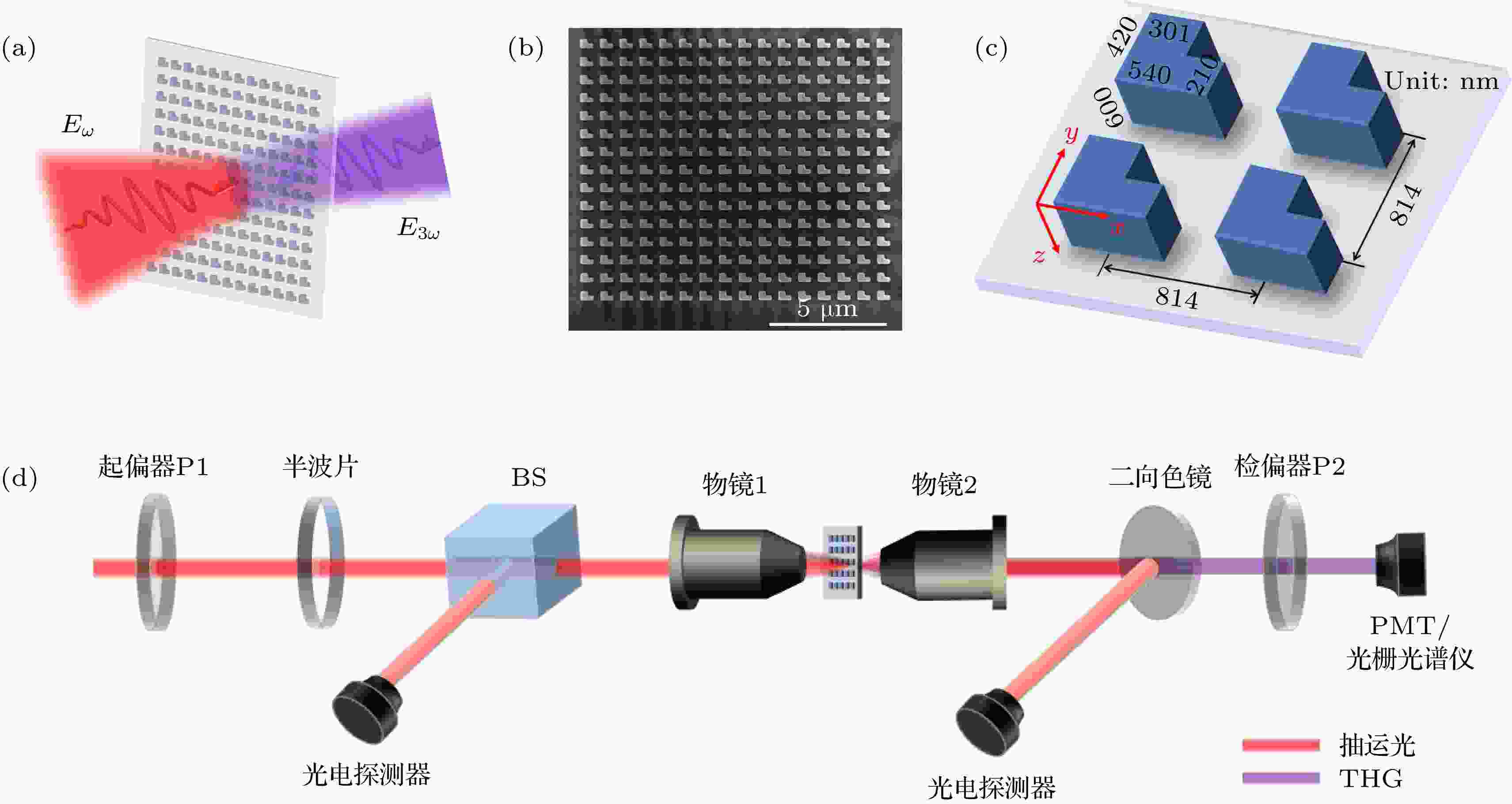
2019, 68 (21): 214207.
doi: 10.7498/aps.68.20190789
Abstract +
We report the enhanced third-harmonic generation (THG) from a silicon metasurface consisting of an array of L-shaped nanoresonators. The L-shaped nanoresonator is designed as a small cuboid with a notch cut from one corner. And 16 × 15 L-shaped nanoresonators are arranged into an array with a square lattice. In order to fabricate the structure, a 600-nm-thick silicon layer is first deposited on a 500-μm-thick sapphire substrate, which is then patterned into the metasurface structure by using electron beam lithography and inductively coupled plasma dry etching process. To evaluate the linear optical property of the fabricated metasurface, a continuous-wave narrow band laser with a tunable wavelength range of 1530−1560 nm is employed to measure the transmission and reflection spectrum. The measurement results show a Fano resonance at a wavelength of 1548 nm when the incident laser is linearly polarized along the long arm of the L-shaped nanoresonator. Pumping at the resonant wavelength, the metasurface shows significant polarization sensitivity for the transmitted light and the reflected light. To excite the THG signal from the metasurface, a femtosecond pulsed laser with a tunable wavelength range of 1540−1560 nm is then employed as the pump. Strong THG signal is observed when the laser wavelength is tuned on the resonant wavelength (1548 nm), indicating a conversion efficiency of ~ 3×10–7. By comparing the THG signals triggered on- and off-resonance, an enhancement factor of 220 is extracted, which is attributed to the field-enhancement of the Fano resonance. The resonance enhanced THG signal also has polarization-dependence with an extinction ratio of 15 dB. These experimental results are verified well by numerical simulations based on a finite-element technique, including the Fano resonance and the enhanced THG process. By combining the numerically calculated electrical field of the resonant mode and the calculation of nonlinear polarizations, the resonance enhanced THG as well as its polarization-dependence are confirmed numerically. The realized strongly enhanced THG from the silicon metasurface promises to extend their linear optical functionalities into nonlinear regime.

2019, 68 (21): 214208.
doi: 10.7498/aps.68.20190673
Abstract +

2019, 68 (21): 214301.
doi: 10.7498/aps.68.20190991
Abstract +
The high-precision molding capability of complex surfaces and structures makes three-dimensional (3D) printing technology more widely used in underwater acoustic models and structural molding. The plastic polymer material, as the main material in the field of 3D printing, possesses the acoustic parameters that are directly related to the acoustic properties of 3D printed underwater acoustic models and structures. Based on the Rayleigh normal series solution for the acoustic scattering of underwater target and the mechanism analysis of the low-frequency resonance which is associated with subsonic Rayleigh waves on the solid plastic polymer spheres, the sensitivity characteristics of the resonance frequency and amplitude to the wave velocity and attenuation coefficient are obtained at low frequencies. It is shown that the transverse wave velocity and the transverse wave attenuation coefficient both have high inversion accuracy at low values of ka, where a is the radius of elastic sphere, as they are quite sensitive to the backscattering resonance frequency and amplitude, respectively. In the frequency band of interest, the backscattering resonance frequency is almost independent of attenuation coefficient. Considering the inversion accuracy, the longitudinal wave velocity and transverse wave velocity are inverted by the resonance frequency separately. Based on these characteristics, the cyclic search method is used to establish an acoustic parameter inversion method for plastic polymer materials, in which the frequency and amplitude of backscattering resonance peak are used as cost functions. Finally, the backscattering acoustic scattering experiment on a solid typical plastic polymer PMMA (methyl methacrylate-acrylic) sphere is conducted in the tank. The experimental results about the backscattering target strength varying with the frequency are in good agreement with the simulation results in a frequency range of 5–20 kHz. The simulation parameters such as the longitudinal wave velocity, transverse wave velocity and attenuation coefficient are obtained by the previously established inversion method. Therefore, the acoustic parameter inversion method provides reliable acoustic parameters for 3D printed underwater acoustic model and structure performance prediction for plastic polymer materials.

2019, 68 (21): 214302.
doi: 10.7498/aps.68.20191131
Abstract +
Aiming at the isolation of low-frequency noise, an acoustic metamaterial is designed based on Helmholtz cavity and thin film structure. It consists of a Helmholtz cavity with film bottom and the mass block attached to the cavity. By the finite element method, the transmission losses and resonance frequencies of metamaterials in a frequency range of 20-1200 Hz are calculated and also verified experimentally. The results show that the metamaterial has great sound insulation performance in the frequency range. There are six sound insulation peaks, of which the two sound insulation peaks below 100 Hz have the transmission losses of 44.29 dB and 67.43 dB, respectively. The maximum transmission loss in the whole frequency range is 90.18 dB. Comparing with the normal Helmholtz cavity or thin film acoustic metamaterial or traditional material, the sound insulation performance of the metamaterial is improved greatly. By analyzing the resonance and vibration mode diagram at the sound insulation peaks comprehensively, the sound insulation mechanism of the metamaterial is further explored. The results show that many resonance modes have no effect on transmission loss only when the resonance mode can be coupled with the incident wave and is not an antisymmetric mode which can affect the transmission loss. The transmission and reflection coefficient of the metamaterial are calculated by the finite element method, and through the method for retrieving effective properties, the effective mass density and effective modulus are obtained. It is found that there is a negative effective mass density at the sound insulation peak, meanwhile the effective modulus is close to zero. The generation mechanism of abnormal equivalent parameters is analyzed from the energy view point. The acoustic impedance of the metamaterial is obtained by an equivalent circuit method, through which the first resonance frequency is calculated relatively accurately. According to the results of the previous study on sound insulation mechanism, the effect of the eccentric mass unit on the sound insulation performance of metamaterial is studied. It is found that the eccentric mass can greatly reduce the antisymmetric resonance mode and increase the sound insulation peak of the structure, which is also verified experimentally. The results provide a reference for designing the acoustic metamaterials.

2019, 68 (21): 214303.
doi: 10.7498/aps.68.20190824
Abstract +
The field of ocean ambient noise contains numerous information about the water column, especially the information about the sub-bottom. The geoacoustics parameters of sub-bottom are very important factors influencing the spatial characteristics of ocean ambient noise field. For different layered structures of the sub-bottom, the bottom-loss shows different critical angles according to sound speed of each layer, while the structure of interference fringe is dependent on the thickness of the sediment. Flux theory of ocean ambient noise proposed by Harrison is used in this paper. Using this theory, the curve of bottom-loss can be extracted by computing the ratio between the energy of the upward wave and the downward wave. From the ideal reflection coefficient, the influence of sound speed, density and attenuation coefficient on reflection coefficient are discussed in the situation of the sub-bottom of acoustic half space, while the reflection coefficient of 1 layer of sediment is simplified. Initially, the reflection coefficient is the sum of sound waves reflect from the sub-bottom transmitted from the same source at the same angle. Only the first two terms are reserved, so that the mechanism of the interference fringe can be easily discussed. The structure of interference fringe can be explained which is affected by the thickness of the sediment. The curve of bottom-loss oscillates periodically with the increase of the thickness of the sub-bottom. Also by the reciprocity principle, the interference fringe of the reflection coefficient can be explained by considering the sound transmitted from two point sources at the surface of the sea. In this way the same result can be obtained as that from the method of simplification. The result of the experiment in China Yellow Sea shows that the information about the reflection coefficient of the sub-bottom can be extracted by the vertical azimuth spectrum of ocean ambient noise. In this way, the critical angle can be obtained, so that the sound speed of the sub-bottom can be estimated by using Snell law. The structure of the interference fringe is also contained in the bottom-loss curve estimated by ocean ambient noise. Therefore the layered structure, sound speed and the thickness of the layer of the sub-bottom can be estimated.

2019, 68 (21): 214304.
doi: 10.7498/aps.68.20190770
Abstract +
Ultrasound-modulated optical imaging technology is a new type of biological tissue optical detection technology, and sensitive to the change of scattering coefficient and absorption coefficient of biological tissue. This technology is a non-ionizing and non-invasive pathological detection method, which has great potential application in early detection of cancer. However, ultrasound-modulated optical imaging technology is insufficient in signal-to-noise ratio (SNR) and imaging contrast. Frequency-shifted laser feedback technology with microchip laser is a new type of highly sensitive interference technology, whose gain coefficient for weak optical signal can reach 106. This technology can greatly improve the SNR of imaging. Combined with the high sensitive laser feedback technology, the ultrasound-modulated laser feedback technology is proposed. The SNR of this technology is better than that of the traditional ultrasound-modulated optical imaging technology. The increase in SNR can achieve greater depth of detection in biological tissue imaging, but there is no significant improvement in imaging contrast. In order to improve the contrast of biological tissue imaging and achieve high resolution imaging of thick biological tissue, we use ultrasound microbubble contrast agent in ultrasound-modulated laser feedback imaging technology. We establish a Monte Carlo photon transport model with microbubbles in order to study the mechanism of contrast enhancement in ultrasound-modulated laser feedback imaging with microbubbles. Finally, we establish an experimental system to verify the correctness of the simulation results. Experimental and simulation results show that in the transparent solution, the ultrasonic microbubble contrast agent can enhance the ultrasound-modulated laser feedback signal and generate harmonic modulation, which can improve the imaging contrast by detecting the enhancement of the fundamental and harmonic signals of the feedback. In the scattering medium, the ultrasonic microbubble contrast agent can significantly attenuate the ultrasound modulated laser feedback signal, and the imaging contrast can be improved by detecting the attenuation of the fundamental and harmonic signal.
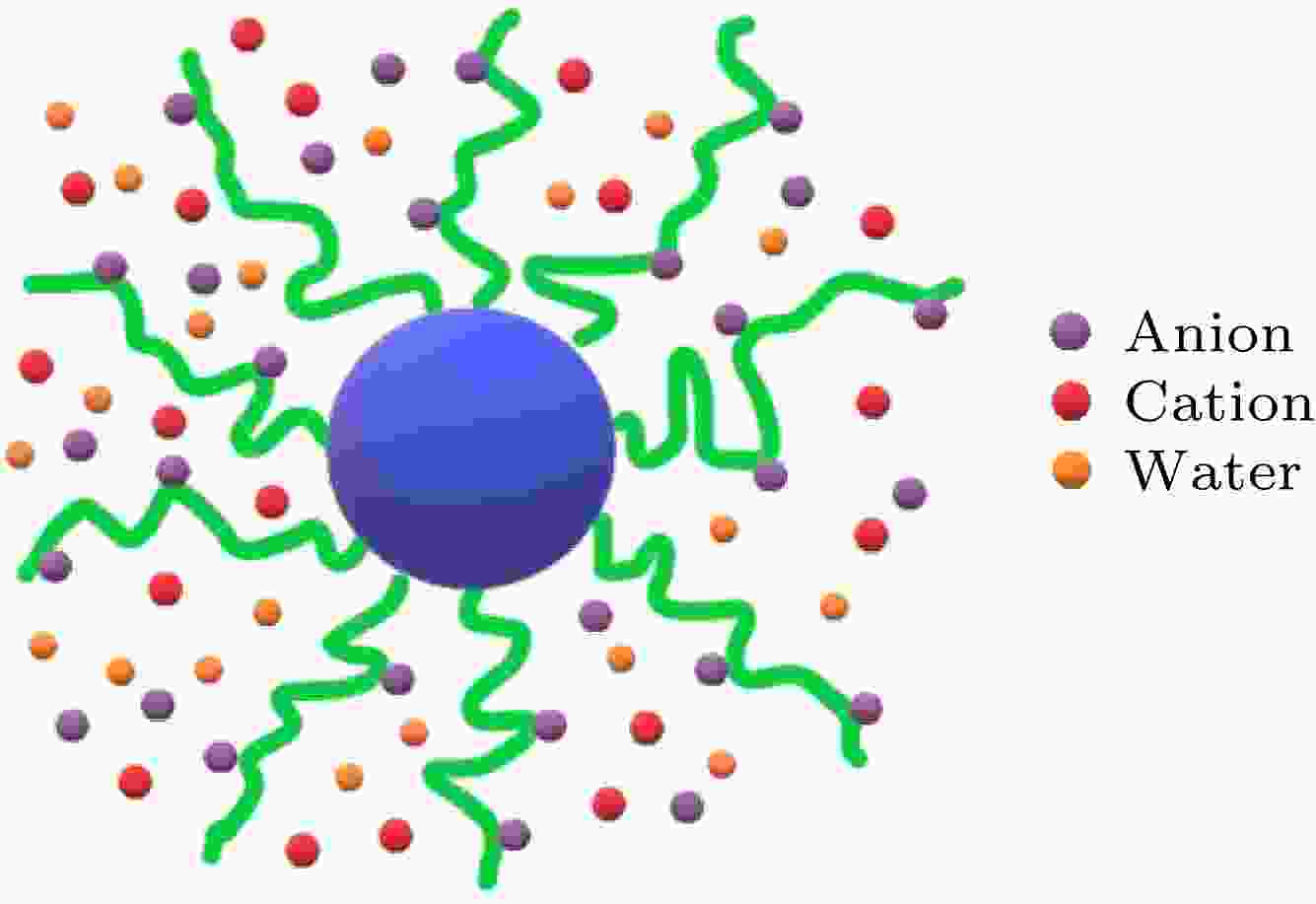
2019, 68 (21): 214701.
doi: 10.7498/aps.68.20190682
Abstract +

2019, 68 (21): 214702.
doi: 10.7498/aps.68.20190873
Abstract +
A new incompressible gas-liquid two-phase flow model for non-Newtonian power-law fluid is proposed based on an incompressible lattice Boltzmann model. And the fundamental physical mechanism of Newtonian fluid displacing non-Newtonian power-law fluid liquid in porous medium is studied by using the proposed model. The effects of capillary number Ca, dynamic viscosity ratio M, surface wettability θ, porous medium geometry, and power law index n on the displacement process are investigated. The comprehensive results show that with the increase of capillary number, the displacement process turns faster, the fingering phenomenon becomes more obvious and the displacement efficiency decreases. However, for different values of power-law index n, the effects of the Ca on the displacement process have some differences. Specially, the decrease rate of displacement efficiency becomes slow if the displaced fluid is shear thickening fluid as compared with that if the displaced fluid is shear thinning fluid. On the other hand, the displacement efficiency decreases as dynamic viscosity ratio M increases. And the effect of the viscosity ratio on the displacement process becomes more obvious for the low value of the power-law index n. Moreover, the effect of the surface wettability of the porous medium on the displacement process is also related to the size of the power-law index. With the increase of the contact angle of the porous medium, the fingering phenomenon turns less obvious, and the displacement efficiency increases. However, with the increase of power-law index n, the influence of the contact angle on the displacement process decreases. Besides, the displacement processes with different geometric types of the porous media are also studied in the work. The results show that comparing with the case of porous medium denoted by circle shape and square shape, the fingering phenomenon obtained by the case of triangular shape is most obvious, and the displacement efficiency is lowest.
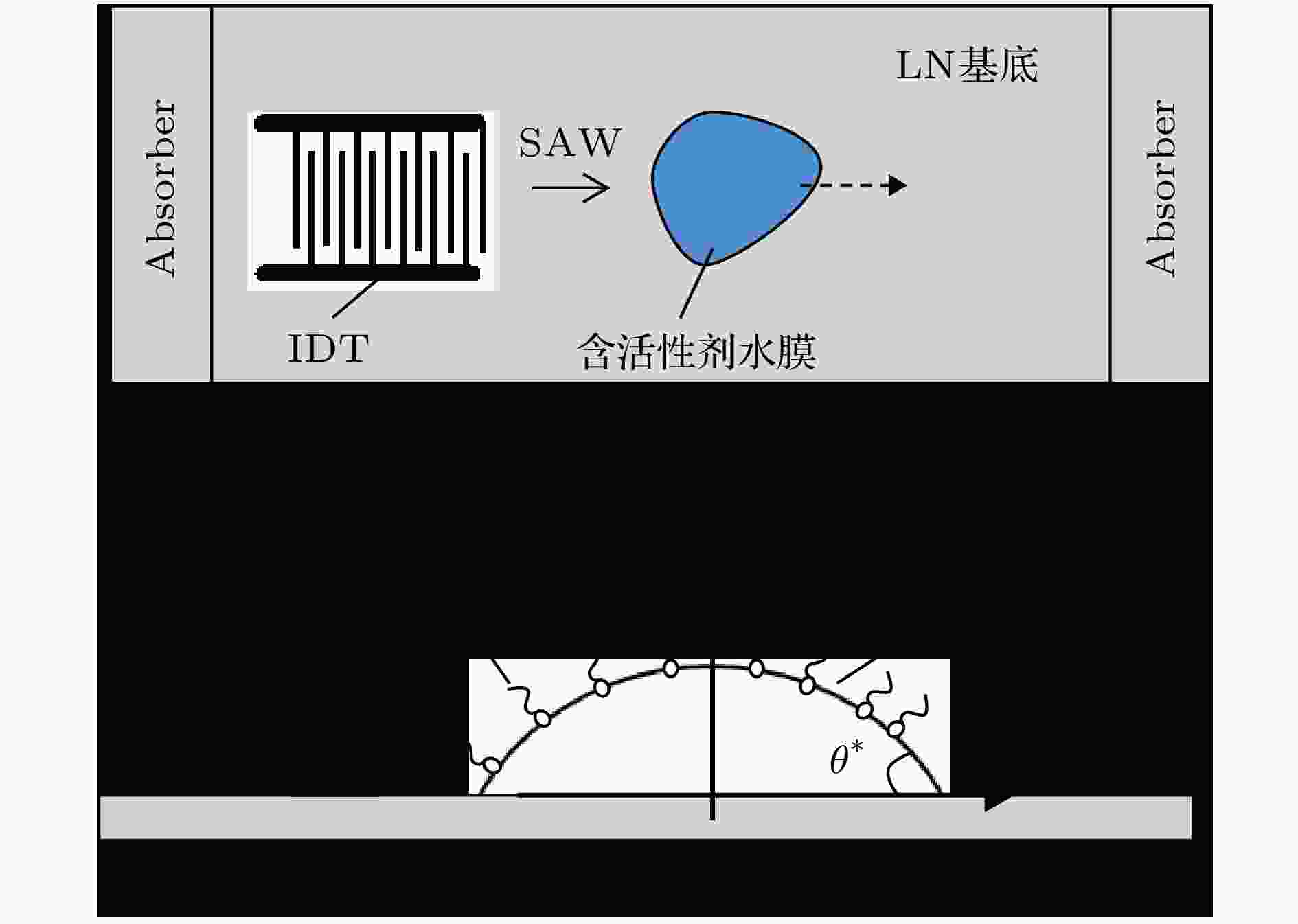
2019, 68 (21): 214703.
doi: 10.7498/aps.68.20190791
Abstract +
For the spreading of thin and free film of a partially wetting liquid with insoluble surfactant under the influence of surface acoustic wave, the dimensionless evolution equations governing the spreading dynamics are derived. The evolution equations contain the film thickness and the surface concentration of insoluble surfactant. Assuming that the thickness of the thin film is much smaller than the wavelength of sound in the liquid, the sound leaking off the surface acoustic wave cannot be sustained in the liquid film, and the acoustic radiation pressure and attenuation of the acoustic wave in the solid are both weak. Then the films spreading under different physical mechanisms are observed by numerical simulation. The results show that the surface acoustic wave drives the liquid film to spread and move. When the capillary stress is weak and the liquid film spreading is mainly controlled by the drift induced by surface acoustic wave, the spreading process consists of rapid spreading stage and balancing stage, and the Marangoni effect caused by uneven distribution of surfactant makes the liquid film spread faster in the first stage. When the capillary stress and the drift jointly dominate film spreading, the spreading process contains three stages, i.e. spreading stage, contracting stage and balancing stage. The effect of surfactant accelerates the spreading process, but the existence of contracting stage makes it take longer for the film to reach equilibrium. In addition, the disjoining pressure used in this paper promotes the liquid film spreading, as well as the Marangoni effect. As the correlation coefficient between disjoining pressure and surfactant concentration, α, and the Marangoni number, M, increase, the maximum thickness and the spreading radius of liquid film change faster.
Original Articles

2019, 68 (21): 217501.
doi: 10.7498/aps.68.20191139
Abstract +
Magnetic refrigeration is a kind of energy-saving, environment-friendly and intrinsically-high-efficient refrigeration technology, which has a wide application prospect. At present, the magnetic refrigeration systems based on active magnetic regenerator cycle have been widely studied and many prototypes of refrigerators have been developed. However, fluids and gases are mainly applied to heat exchange in these systems, which brings some problems such as low operating frequency, large regenerative loss, and complicated sub-component design. These problems increase the cost and reduce the efficiency of magnetic refrigerators. In view of the above problems and challenges, researchers try to introduce the solid-state heat transfer enhancement mechanism, and to design and optimize the full-solid-state magnetic refrigeration system model. In this paper, the development process of magnetic refrigeration technology at room temperature is briefly introduced at first. And the reasons for the low operating frequency and efficiency of the magnetic refrigerator, caused by using fluids for heat exchange, are analyzed. Then, two types of solid-state heat exchange media are briefly described, which are thermal diodes (i.e., electric-field-controlled thermal diode and magnetic-field-controlled thermal diode) and high thermal-conductivity material elements. In this paper we review the research progress of the full-solid-state magnetic refrigeration model based on thermal diodes and high thermal-conductivity material elements. Some key items for these models are described in detail, such as the architectural design concept, physical mechanism and working principle, the main performance simulation results of these systems and their physical change rules. Then, the main performances (i.e. operating frequency, specific cooling power, temperature span, and coefficient of performance) of the full-solid-state magnetic refrigeration model and the AMR model are summarized and comparatively analyzed. It shows that the full-solid-state magnetic refrigeration system can work at high frequency and has greater specific-cooling-power. Meanwhile the design of full-solid-state magnetic refrigeration system is more compact and simpler. The characteristics and problems of the two types of solid heat exchange media are also analyzed. Due to the strong thermal transport capability, easy access and integration of thermoelectric elements, the full-solid-state magnetic refrigeration technology based on thermoelectric thermal diodes has greater application potential. Finally, the main research directions and key scientific problems for further studying the full-solid-state magnetic refrigeration field are discussed and analyzed.
GENERAL
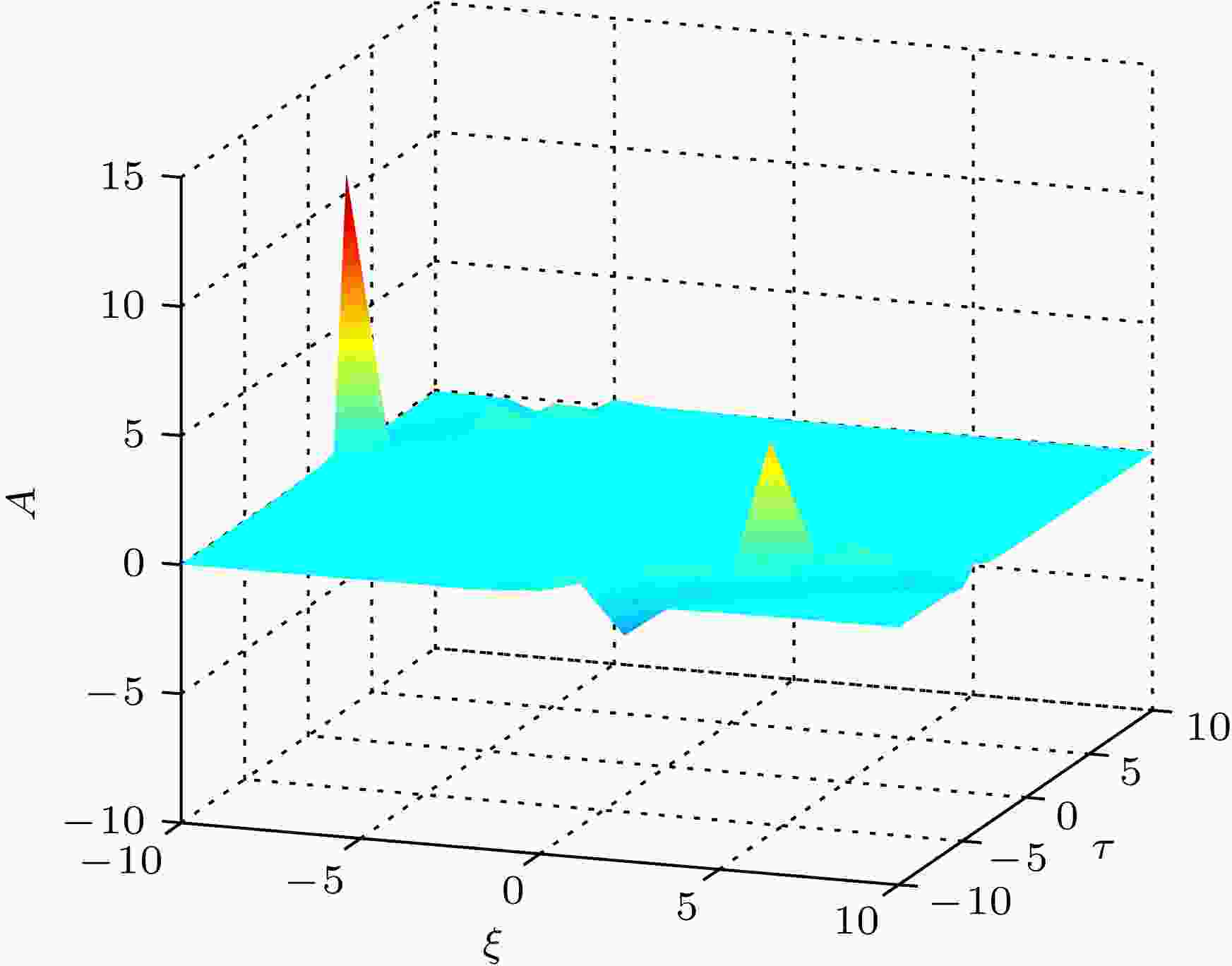
2019, 68 (21): 210201.
doi: 10.7498/aps.68.20191045
Abstract +
In recent years, the dust plasma research plays an important role in the field of space, industry, and laboratory. In this paper, starting from the control equations of the double temperature dust plasma, we derive the (2+1)-dimensional Kadomtsev-Petviashvili (KP) equation to describe the double temperature dust plasma sound waves by using the multi-scale analysis, and reduce it by using the perturbation method. Then by using the semi inverse method and fractional variational principle, the (2+1)-dimensional KP equation is introduced into the time-space fractional KP equation (TFS-KP). The fractional KP equation has potential applications in describing physical phenomena in practical problems. Furthermore, based on the symmetrical analysis method, by which lie discussed the time fractional KP (TF-KP) equation of the conservation law, the dual temperature dust plasma acoustic conserves quantity. Finally, based on the bilinear method, the lump solution of fractional KP equation is obtained. The existence of this solution indicates the rogue waves existing in double temperature dusty plasma. The influence of fractional order on rogue wave is also analyzed.

2019, 68 (21): 210501.
doi: 10.7498/aps.68.20190952
Abstract +
Aiming at the reception of the intermediate frequency signal of sine wave of radio and communication system at extremely low signal-to-noise ratio (SNR), a quadratic polynomial receiving scheme for sine signals enhanced by stochastic resonance (SR) is proposed. Through analyzing the mechanism of sine signals enhanced by SR and introducing the decision time, the analytic periodic stable solution with time parameters of the Fokker-Planck Equation (FPE) is obtained through converting the non-autonomous FPE into an autonomous equation. Based on the probability density function of the particle of SR output, a quadratic polynomial receiving scheme is proposed by analyzing the feature of energy detector and matching filter receiver. By maximizng the deflection coefficient, the binomial coefficients and the test statistic are obtained. For further reducing the bit error, by combining the thought of " the average of N samples”, a quadratic polynomial receiving scheme for sine signals enhanced by SR is proposed through the hypothesis under Gaussian distribution approximation of the law of large N. And the conclusion is obtained as follows. When N is 500 and the SNR is greater than –17 dB, the bit error rate is less than 2.2 × 10–2, under the constraint of the parameters of the optimally matched SR.
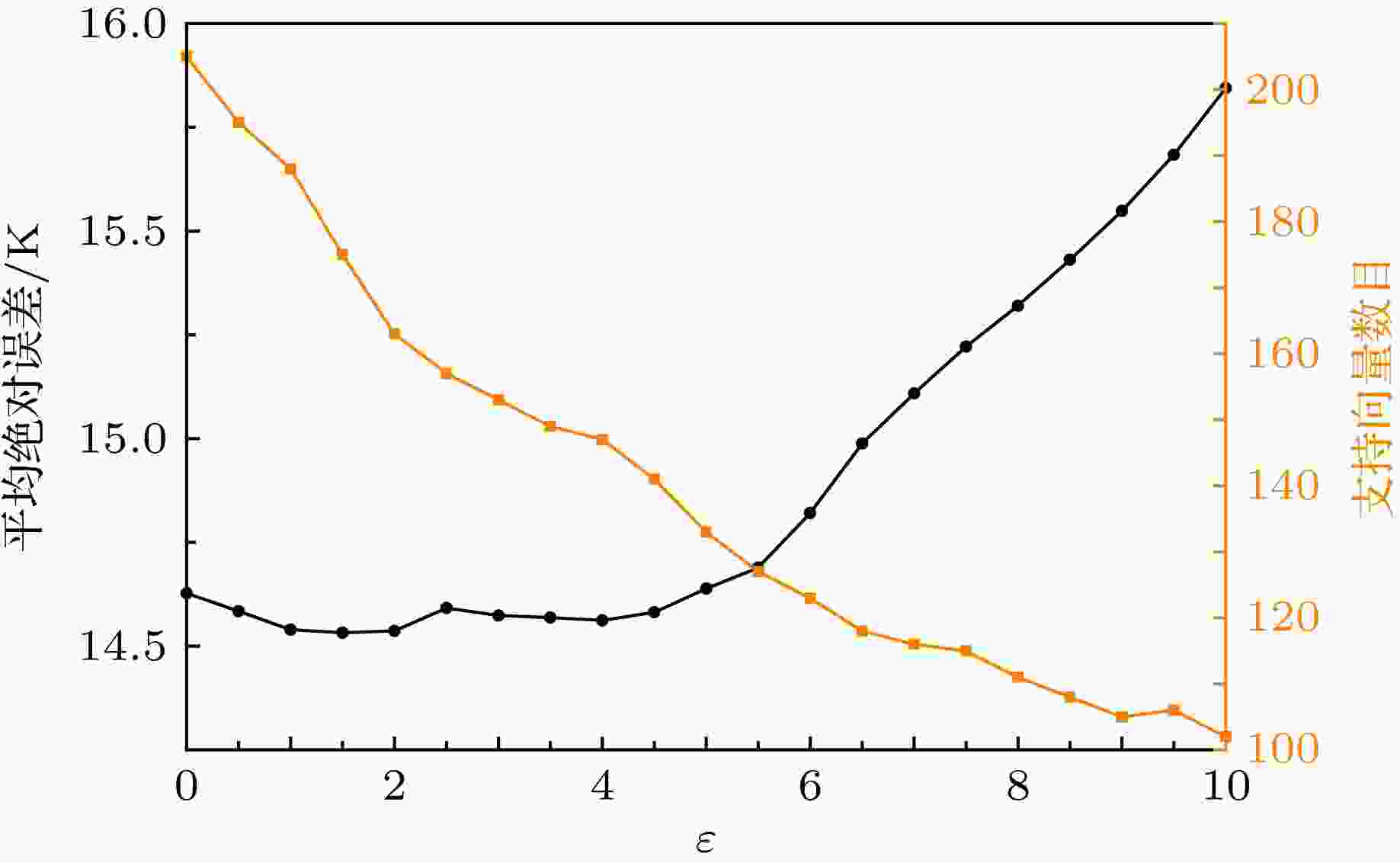
EDITOR'S SUGGESTION
2019, 68 (21): 210502.
doi: 10.7498/aps.68.20190942
Abstract +
Ferroelectrics undergoes a reversible structural phase from the ferroelectric phase to the paraelectric phase when its temperature exceeds the critical temperature namely Curie temperature Tc. As ferro-paraelectric phase transition is always accompanied by heat-flow, dielectric and pyroelectric anomaly, the value of Tc is extremely important for ferroelectrics. In this paper, the Curie temperature of lead-based perovskite ferroelectric solid solution is studied by machine learning methods including kernel ridge regression (KRR), support vector regression (SVR) and extremely randomized trees regression (ETR). We collect the Tc values of 205 different lead-based perovskites from published experimental papers, both simple perovskites with only one type of B site ion and complex perovskites with up to 5 kinds of ions in B position such as PMN-PFN-PZT are gathered. The diversity of our dataset is guaranteed for the good generalization of our model in perovskite solid solution of different complexity. The features are constructed from the physical and chemical properties of the B site elements in corresponding materials. The weighted-average and variance of the elemental properties are calculated and fed to machine learning models. We use the 5 runs of ten fold cross-validation method to evaluate the machine learning models. The hyperparameters are also chosen carefully with the cross-validation to avoid over fitting. The radial basis function kernel is used in both KRR and SVR. The insensitive error in the SVR is set to be 4 which is comparable to the random error in experiment. From our cross-validation, we find that the mean average errors (MAEs) between the predicted and experimental values of the machine learning methods are 14.4 K, 14.7 K, and 16.1 K, respectively. And the root-mean-square errors (RMSEs) are 22.5 K, 23.4 K, 23.8 K, respectively. After the optimization and the evaluation, our three machine learning models are stacked together by averaging the output of each regression model and thus building an ensemble model. The MAE of the ensemble model is 13.9 K. The RMSE of the ensemble model is 21.4 K. The predicted values keep a correlation coefficient of 0.97 with the experimental values. From the variance reduction in ETR, we derive the importance of our features when determining the Curie temperatures. The five most important factors in our ETR model are " weighted-average thermal conductivity”, " weighted-average conductivity”, " variance of specific heat capacity”, " weighted-average element number”, and " weighted-average relative atomic displacement”. We predict the Curie temperatures higher than those of 200000 types of lead-based perovskites after being trained. Now, we provide two ferroelectric materials that may have high Curie temperatures: 0.02PbMn1/2Nb1/2O3-0.98PbTiO3 (0.02PMN-0.98PT) and 0.02PbGa1/2Nb1/2-0.02PbMn1/2Nb1/2O3-0.96PbTiO3 (0.02PGN-0.02PMN-0.96PT). The predicted Curie temperatures of them are 481 ℃ and 466 ℃, respectively.
ATOMIC AND MOLECULAR PHYSICS

EDITOR'S SUGGESTION
2019, 68 (21): 213301.
doi: 10.7498/aps.68.20191192
Abstract +
In order to obtain the Er3+/Yb3+ co-doped Ba5Gd8Zn4O21 up-conversion phosphor material with maximum red luminous intensity, three steps are adopted as follows. Firstly, the uniform design in the experimental optimal design is used to find the reasonable doping concentration of Er3+/Yb3+. Secondly, according to the quadratic general rotary unitized design, the regression equation of the red luminescence intensity of Er3+/Yb3+ co-doped Ba5Gd8Zn4O21 under 980 nm and 1550 nm excitations is established. Finally, the optimal solution of the regression equation is obtained by genetic algorithm. The Ba5Gd8Zn4O21:Er3+/Yb3+ phosphors are prepared by a high-temperature solid-phase method. The crystal structure for each of the prepared phosphors is analyzed by X-ray diffraction, and it is confirmed that the prepared phosphor samples of Ba5Gd8Zn4O21 are all in pure phase. Using the 980 nm laser as an excitation source, the relationship between the red up-conversion luminescence intensity of the optimal sample and the operating current of the laser is studied. It is found that the red luminescence is emitted through a double-photon process by the formula fitting analysis. Using the 1550 nm laser as the excitation source, it is found that red luminescence is emitted through a three-photon process. The up-conversion emission spectrum of the optimal sample with respect to temperature is measured and discussed, and it is found that the red up-conversion luminescence intensity of the sample is weakened as the temperature increases. The optimal samples are compared with the commercial phosphors of NaYF4:Er3+/Yb3+ under the 980 nm and 1550 nm excitation respectively, the luminescence intensity of the optimal sample is much stronger than that of the commercial phosphor of NaYF4:Er3+/Yb3+. Moreover, under the same power density excitation, the red up conversion luminescence intensity of the optimal sample at 980 nm is stronger than that at 1550 nm.
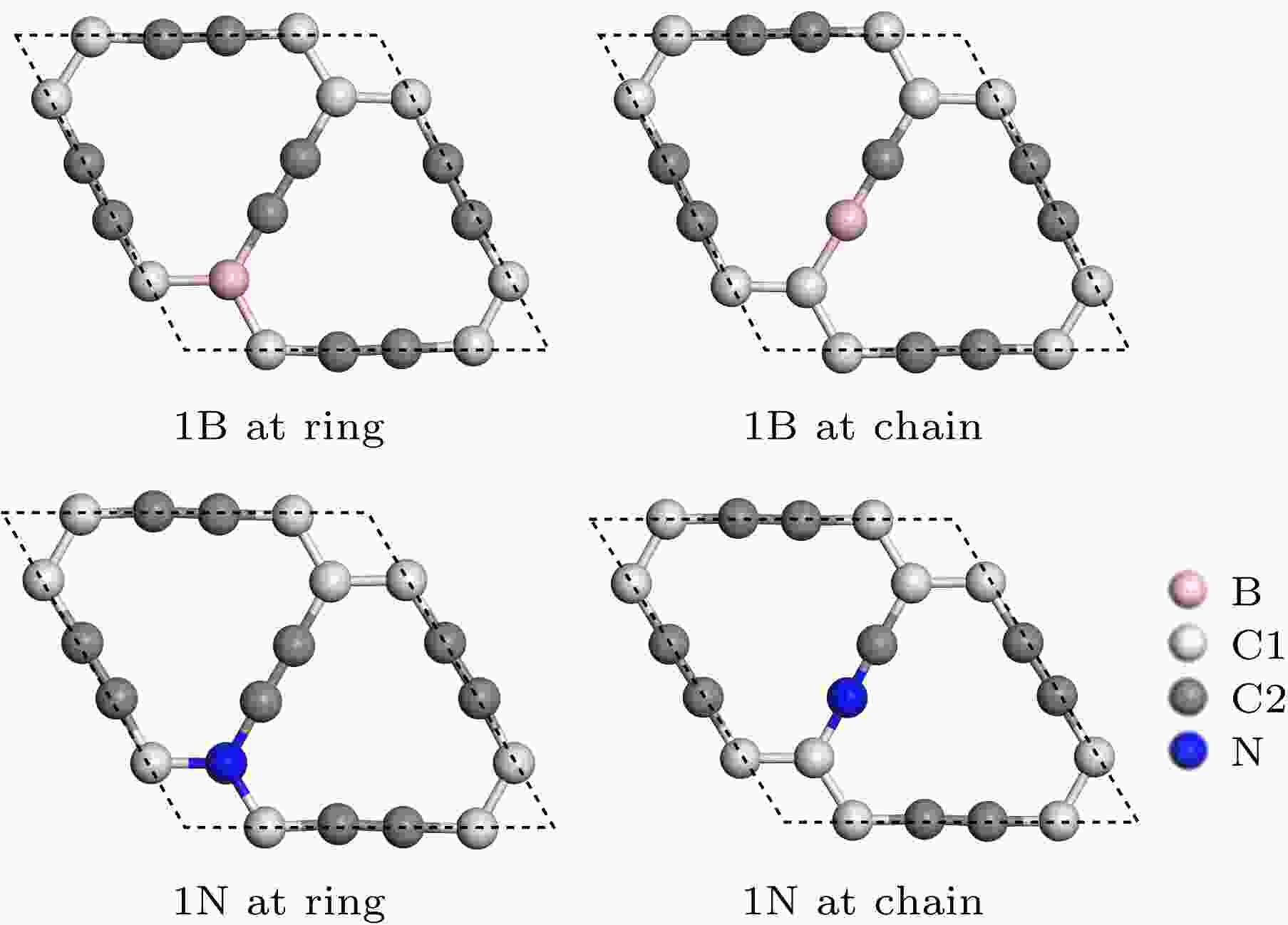
2019, 68 (21): 213601.
doi: 10.7498/aps.68.20191161
Abstract +
As the economy grows and the environment deteriorates, the renewable energy is urgently needed. The advanced energy storage technology in electronic equipment, electric vehicle, smart grid, etc. becomes more significant. For example, the rechargeable batteries, hydrogen storage media, supercapacitors, the new energy storage devices have received much attention today. The anodes of the lithium ion battery (LIB), as the main body of charging and discharging, should be most important. The ideal anode material for LIBs is required to possess a higher Li capacity and a lower volume expansion. Good reversibility and high Li capacity are balanced necessarily in the electrode material. The poor cycling performance of LIB is usually due to the severe volume expansion of anode in lithiation/delithiation process. In this paper, the Li storage performance of B and N doped graphyne is explored by using the density functional theory method. The Perdew-Burke-Ernzerhof functional of the generalized gradient approximation is chosen. The calculations indicate that the doping of B atoms can enhance the adsorption strength between the Li atom and the graphyne, which can greatly increase the Li storage capacity. The Li storage capacity of B doped graphyne can reach as high as 2061.62 mAh/g, which is 2.77 times that of pristine monolayer graphyne. Meanwhile, the B doping reduces the out-plane diffusion energy barrier of Li, but increases the in-plane diffusion energy barrier slightly by 0.1 eV. On the other hand, the doping of N atoms reduces the interaction between Li and graphyne, however, the Li capacity also increases to 1652.12 mAh/g because the number of the available Li adsorption sites increases. Moreover, the doping of N atoms greatly improves the diffusion performance of Li on graphyne. The in-plane diffusion energy barrier drops to 0.37 eV, and thus the charge-discharge performance of the N doping graphyne is well improved. Therefore, the doping of B and N atoms can remarkably improve the performance of graphyne as the LIB anodes. The remarkable performance of B and N doped graphdiyne shows that it will become a promising LIB anode in the future. The present research can provide a good theoretical basis and thus conduce to guiding the developing of good Li storage materials, and can also supply strong background for experimental researches.
PHYSICS OF GASES, PLASMAS, AND ELECTRIC DISCHARGES

2019, 68 (21): 215101.
doi: 10.7498/aps.68.20190734
Abstract +
In this paper, the dynamics of hollow cathode discharge in argon is simulated by fluid model. In the numerical model considered are 31 reaction processes, including direct ground state ionization, ground state excitation, stepwise ionization, Penning ionization, de-excitation, two-body collision, three-body collision, radiation transition, elastic collision, and electron-ion recombination reaction. The electron density, Ar+ density, Ar4s, Ar4p, Ar3d particle density, electric potential and electric field intensity are calculated. At the same time, the contributions of different reaction mechanisms for the generation and consumption of electron, Ar4s and Ar4p are simulated. The results indicate that hollow cathode effect exists in the discharge, and the Ar4s density is much higher than electron density. The penning ionization 2Ar4s → Ar+ + Ar+ + e and stepwise ionization involving Ar4s make important contributions to the generation of new electrons and the balance of electron energy. In particular, the penning ionization reaction 2Ar4s → Ar2+ + e, which is generally ignored in previous simulation, also has an significant influence on electron generation. The spatial distribution of excited state argon atomic density is the result of the balance between the formation and consumption of various particles during discharge. Radiation reaction Ar4p → Ar4s + hν is the main source of Ar4s generation and the main way to consume Ar4p. Ar4s + e →Ar4p + e is the main way of Ar4s consumption and Ar4p production. The simulation results also show that the Ar4p density distribution can better reflect the optical characteristics in the hollow cathode discharge.

2019, 68 (21): 215201.
doi: 10.7498/aps.68.20190440
Abstract +
Inertial confinement fusion (ICF) is one of the possible ways to realize controlled thermonuclear fusion. The fusion neutron source term is one of the important parameters in the physical design and analysis of laser plasma. The accuracy of the fusion neutron source term directly affects the reliability of the analysis results. At present, the neutron source term of deuterium-tritium fusion reaction in ICF is mainly based on formula method. It has limited applications in temperature and reaction type. Because of a large quantity of data, it is impossible to simulate the fusion reaction of each particle. In this paper, the concept of particle cloud is introduced, that is, the collection of the like particles with the same position and speed, and it is considered that the action of particle cloud is the same reaction. Because the particles should satisfy the Maxwell velocity distribution at a certain temperature and the direction is all around the circumference angle, the collision cross sections between the incident particle and different target particles are different. Therefore, the design program takes all the possible velocities, polar angles and direction angles, reads the collision cross sections between deuterium and tritium and makes corrections, and obtains the multi-temperature differential correction cross sections of deuterium and tritium fusion with Doppler energy broadening. On these bases, Monte Carlo method and discrete ordinate method method are used. A numerical simulation program for the fusion rate of D-T particles in laser plasma is developed in this paper. It is found that there are significant differences between the DT, DD, TD cross sections and the original cross sections after Doppler broadening. In a range of plasma temperature between 20 keV and 100 keV, the simulation results are more consistent with the cross section data of ENDF/B-VI and ENDF/B-VII databases of deuterium-tritium fusion reaction than those from the analytical formula method. There is a large error between the numerical simulation results and the analytical formula method in the low energy region. It may be caused by the difference of calculation methods and too big difference among the used fusion cross sections at low temperature.
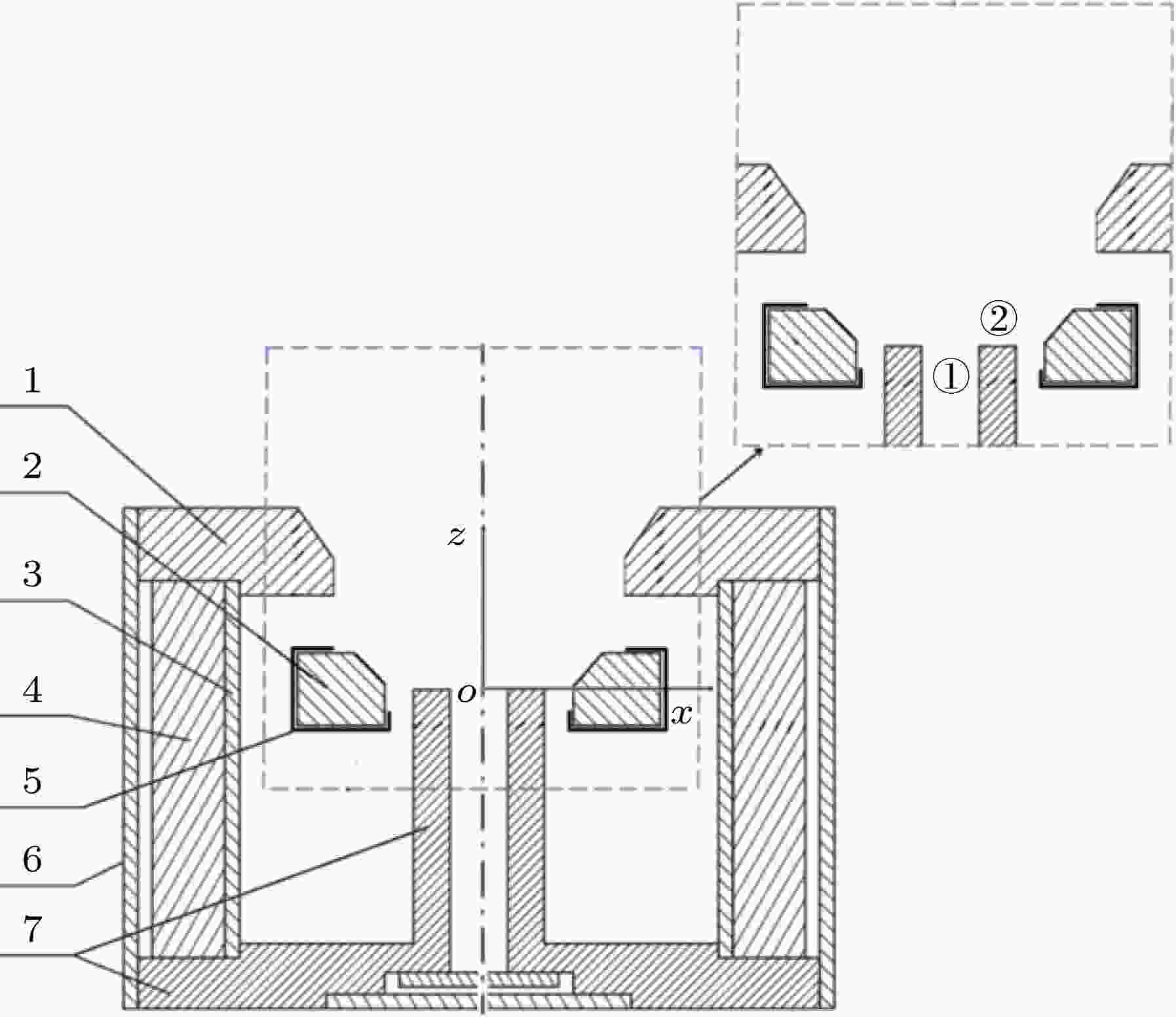
2019, 68 (21): 215202.
doi: 10.7498/aps.68.20190654
Abstract +
For anode layer Hall plasma thruster, the etching of inner magnetic pole is one of the key factors affecting its service life. In order to solve the problem of inner magnetic pole etching in anode layer Hall plasma thruster, the effect of anode magnetic shield on inner magnetic pole etched in anode layer Hall thruster is studied by combining particle simulation PIC with sputtering simulation. The magnetic shielding of anode changes the distribution of magnetic field configuration on the surface of the anode, and improves the magnetic mirror ratio of the magnetic mirror field of the thruster to the magnetic field width of the positive gradient on the central axis. The ratio of the magnetic mirror is 1.4 times that of the original one, and two additional saddle magnetic fields are added on both sides of the original saddle magnetic field region. It not only is conducive to confining electrons and improving the ionization rate of working gas, but also keeps a certain distance between the anode and the high temperature electron region, which provides the reliable reference data for the design of high power Hall plasma thruster. When the discharge voltage is 900 V and the working pressure is 2 × 10–2 Pa, the simulation results show that after the anode is shielded by the magnetic shield, the energy range of most of the incident ions on the inner magnetic pole is 40–260 eV, which is 100 eV lower than the energy range 40–360 eV in the case without shielding the anode. The probability distribution of particle energy without magnetically shielding the anode between 260 eV and 600 eV is obviously higher than that of ion energy with magnetically shielding the anode. The maximum probability distribution of cosine value of incident angle is extended from a small range near 0.1 (incident angle 84°) to a large range of 0.1–0.45 (incident angle 84°–63°). The magnetic shielding makes the incident ions disperse on the surface of the inner magnetic pole, which is helpful in reducing the etching of inner magnetic pole. The maximum etching rate of inner magnetic pole after the anode has been magnetically shielded is reduced from 16 × 10–10 m/s to 6.1 × 10–10 m/s, which is 2.62 times lower. The comparison of simulation results with experimental results in the case without magnetically shielding the anode shows that they are in good agreement.
CONDENSED MATTER: STRUCTURAL, MECHANICAL, AND THERMAL PROPERTIES
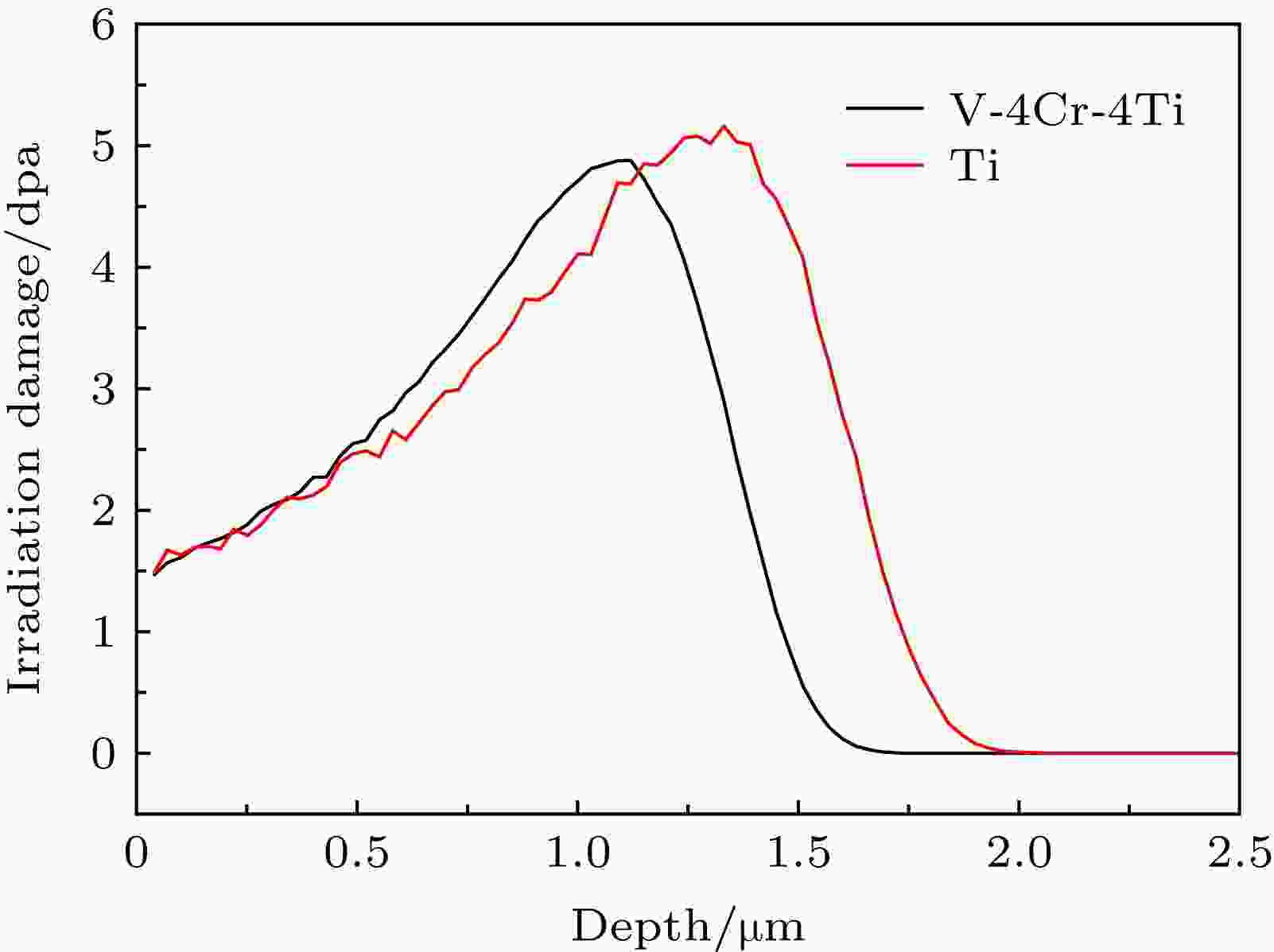
2019, 68 (21): 216101.
doi: 10.7498/aps.68.20191204
Abstract +
The development of electrically insulating coatings is extremely important for the lithium/vanadium (Li/V) blanket of the fusion reactor. However, Li/V cladding materials suffer many problems such as tritiumpermeation and material corrosion. Thus, it is very important to find suitable insulating, tritium-resistant and corrosion-resistant coatings. So, the " V-alloy/Ti/AlN” bilayer coating was proposed by our group in previous study for the first time. In this paper, the evolution of the hardness, irradiation defects and microstructure of the Ti-clad V-4Cr-4Ti composite material after Fe10+ implantation are studied by transmission electron microscopy (TEM) and nanoindentation. According to the characteristics of the composition and microstructure, V-4Cr-4Ti/Ti composite material can be divided into four zones: V-4Cr-4Ti matrix, interface I (the interface near V-4Cr-4Ti matrix), interface II (the interface near Ti matrix), and Ti matrix. The nanoindentation results show that radiation hardening occurs in all regions during irradiation. The radiation hardening in the interface is lower than in the V-4Cr-4Ti and Ti matrix. Thus, the interface of heterogeneous material exhibits fine resistance to radiation hardening. The experimental values of hardness are much higher than the values calculated by the dispersed barrier hardening model. One reason for the discrepancy is that the theoretical values are calculated under the hypothesis of the uniform loop distribution. Actually, a large number of dislocation loops accumulate and tangle with each other in the samples. In addition, the formation of the precipitates is also one of the key factors. The TEM results show that the irradiation defects in the interface are low in density, large in size, and uniform in distribution. As a contrast, high density, small size and twisted dislocation loops are observed in irradiated V-4Cr-4Ti and Ti matrix. These results indicate that the interface can play a critical role in the resistance to irradiation damage. Few tiny Ti-rich precipitates appear in the V-4Cr-4Ti matrix, while there are large quantities of Ti precipitates in the interface after irradiation. Moreover, the number and size of precipitates in the interface I are larger than those in the interface II due to the formation of a few V-rich precipitates in the interface I. The formation of precipitations changes the proportion of V/Ti, which leads to the transformation from β-Ti to α-Ti in the interface.

2019, 68 (21): 216201.
doi: 10.7498/aps.68.20182125
Abstract +
Grain boundary (GB) plays a key role in determining the electrical and mechanical properties of mono-layer transition metal dichalcogenide (TMDC), however it is still a challenge to uncover the GB-mediated TMDC material experimentally. In this paper, the effect of twin boundary on the tensile behaviors of mono-layer MoS2 is investigated by using the molecular dynamics simulation combined with the Stillinger-Weber potential. Mono-layer MoS2 model under the varied size and temperature condition is adopted. Stress calculation is performed by using Virial theorem. The results are obtained as follows. 1) Twin boundary promotes the brittle fracture of an undefected mono-layer MoS2 sheet by inducing the nucleation of the crack near boundaries, thus the fracture strength and strain are weakened. 2) Increasing the ambient temperature from 1 K to 600 K, the crack nucleation process near the twin boundary is intensely accelerated, and the fracture strength and strain are further declined. 3) Twin lamellar spacing also plays an important role in the tensile process of mono-layer MoS2, and the specimen with dense twin boundary, especially with void, shows higher fracture strain. 4) Stress analysis at an atomic level outlines the stress concentration caused by voids and the shielding effect of twin boundary. Because of the interactions between voids and twin boundary, the fracture strength and strain of a voided mono-layer MoS2 sheet can be greatly improved.
CONDENSED MATTER: ELECTRONIC STRUCTURE, ELECTRICAL, MAGNETIC, AND OPTICAL PROPERTIES

2019, 68 (21): 217101.
doi: 10.7498/aps.68.20190539
Abstract +
The crystal structure of carbon monoxide has been studied for more than half a century. The internal structures of low-pressure carbon monoxide crystals have been investigated by means of infrared analysis and Raman analysis, and the internal structure of carbon monoxide has also been studied through computational analysis. Previous studies showed that carbon monoxide can produce different phase transitions at different pressures, and thus forming new polymers with new physical properties such as electrical, optical and mechanical properties. In this paper, from first-principles calculations, we propose six nanotube structures made of carbon monoxide, named Tube-3–Tube-8. The nanotubes are packed into the nanotube bundles, and carbon monoxide nanotube bundle structures that are similar to carbon nanotube bundles are constructed by first-principles calculation. We study the structural, energy and electronic properties of the nanotubes and nanotube bundles. In order to evaluate the relative stability of the predicted nanotubes, we calculate the cohesive energy and phonon spectrum, and we also carry out the molecular dynamics analysis. The results show that there are three nanotubes (Tube-4–Tube-6) that are relatively stable, of which Tube-5 nanotube is the most stable phase. We attribute the stability of Tube-5 to sp3-hybridized C atoms being nearest to the hybridized atoms of diamond. Then we investigate nanotube bundles from the three stable nanotubes, and accordingly name them Bundles-4–Bundles-6. We calculate the enthalpy function under pressure and compare it with the enthalpy function of several known carbon monoxide molecular crystal and chain crystal, which are the most stable structures according to the current studies. More pleasingly, we find that these nanotube bundles are more stable than these carbon monoxide molecular crystal and chain crystal at low pressure. In addition, by calculating the energy bands of Tube-4–Tube-6, we can deduce that these nanotube bundles (Bundles-4– Bundles-6) are all wide band gap semiconductors, which are entirely different from molecular and chain crystals that are metals. We expect that the discovery of nanotube bundle structures will increase the diversity of carbon monoxide crystal under low pressure, and provide a new understanding of exploring the internal structure of carbon monoxide crystal.

2019, 68 (21): 217102.
doi: 10.7498/aps.68.20191010
Abstract +
Pure and In-doped orthorhombic Bi2WO6 are synthesized by sol-gel method through using raw materials Bi(NO3)3·5H2O, In(NO3)3·6H2O, (NH4)2WO4 and surfactants citric acid, polyethylene glycol. All samples are in pure phase without impurity phase as indicated by X-ray diffraction characterization. The In-doped sample degradation efficiency for rhodamine B is higher than that for pure phase with the optimal content 7% mole ratio. Because indium impurity adhering to Bi2WO6 nucleus surface may affect the crystallization range, the sample morphology gradually becomes fluffy and regular, which is reveled through scanning electron microscopy analysis. This morphology change plays an important role in electron-hole transport process as well as contact area of carrier and organic molecule. Using X-ray photoelectron spectroscopy (XPS) characterization and Gaussian fitting, it is found that the O 1s XPS peak of pure and In-doped sample each contain three peak sites. The low energy peak around 530 eV originates from W—O and Bi—O bond. The high peak is ascribed to lattice oxygen defect and its intensity is enhanced gradually with the increase of In content. Thus the increase of oxygen vacancies is the main reason for this photocatalytic performance improvement. Comparing with the impurity-free sample, the visible absorption of In-doped Bi2WO6 is enhanced and the corresponding band gap slightly decreases, which is indicated by diffraction reflection spectroscopy measurement. The reduction of forbidden band width further enhances the photocatalytic performance. After configuration relaxation and self-consistence calculation, the formation energy obtained from a single oxygen vacancy model is less than those from the Bi1In + VO and the Bi2In + VO co-doping models, and greater than the WIn + VO formation energy. This result indicates that indium replacing W site can promote the generating of oxygen vacancies. The calculation of the 18%-hybridization function electronic structure shows that the Bi2WO6 has indirect band gap semi-conduction with energy gap 2.76 eV, which is consistent with the experimental value 2.79 eV. A series of new local states appears in the band gap and near conduction band bottom based on the oxygen vacancy model. These local states promote light absorption and enhance photocatalytic performance. In conclusion, the enhanced photocatalytic performance of Bi2WO6 is attributed to the indium entering into the tungsten site rather than the bismuth site as indicated by the experimental and theoretical result.

2019, 68 (21): 217103.
doi: 10.7498/aps.68.20190660
Abstract +
In this work, the competitive adsorption behavior of H2 and CO on strained Fe(110) are investigated by the first-principles method based on the spin-polarized density functional theory to study the hydrogen embrittlement of steels. The results show that the most stable adsorption site for CO is top site, and the orbital of CO molecule hybridizing with Fe 3p and 4s states illustrates a strong electronic interaction between them. The adsorption energy values of CO at the four calculated adsorption sites are more negative than those of H2, which favors the binding with Fe(110) surface. The potential energy variations for CO and H2 molecules close to the surface are calculated. The attractive force of the Fe(110) surface acting on CO in 1.5–3 Å is greater than that acting on H2. The pre-adsorbed CO increases the dissociation energy barrier of H2 from 0.08 eV to 0.13 eV but reduces the force between H2 and surface. The surface tensile strain enhances the interaction between hydrogen and Fe(110), which, however, is reduced by the compressive strain. The opposite tendency is found in the adsorption of CO. The binding strength of CO is stronger than that of H2 on the strained Fe(110) surface. The difference in adsorption energy between CO and H2 decreases with tensile strain increasing. The effect of surface strain and partial pressure of CO gas phase on the surface coverage ratio of H atom are also calculated quantitatively based on thermodynamics at 298 K, with the partial pressure of H2 set to be 10 MPa. The surface ratio of the H atom decreases with partial pressure of CO increasing. The hydrogen coverage drops nearly to zero when the partial pressure of CO reaches a certain value. This result reveals that CO can inhibit hydrogen adsorption on Fe surface. In the case where the surface ratio of hydrogen decreases to 1%, the corresponding CO partial pressures are 105 Pa, 1.1 × 103 Pa, 2.4 × 105 Pa on –2%, 0, 2% strained Fe(110) surface, respectively. High CO partial pressure is needed to suppress the hydrogen adsorption since the binding strength of CO is close to that of H2 on the expanded surface.
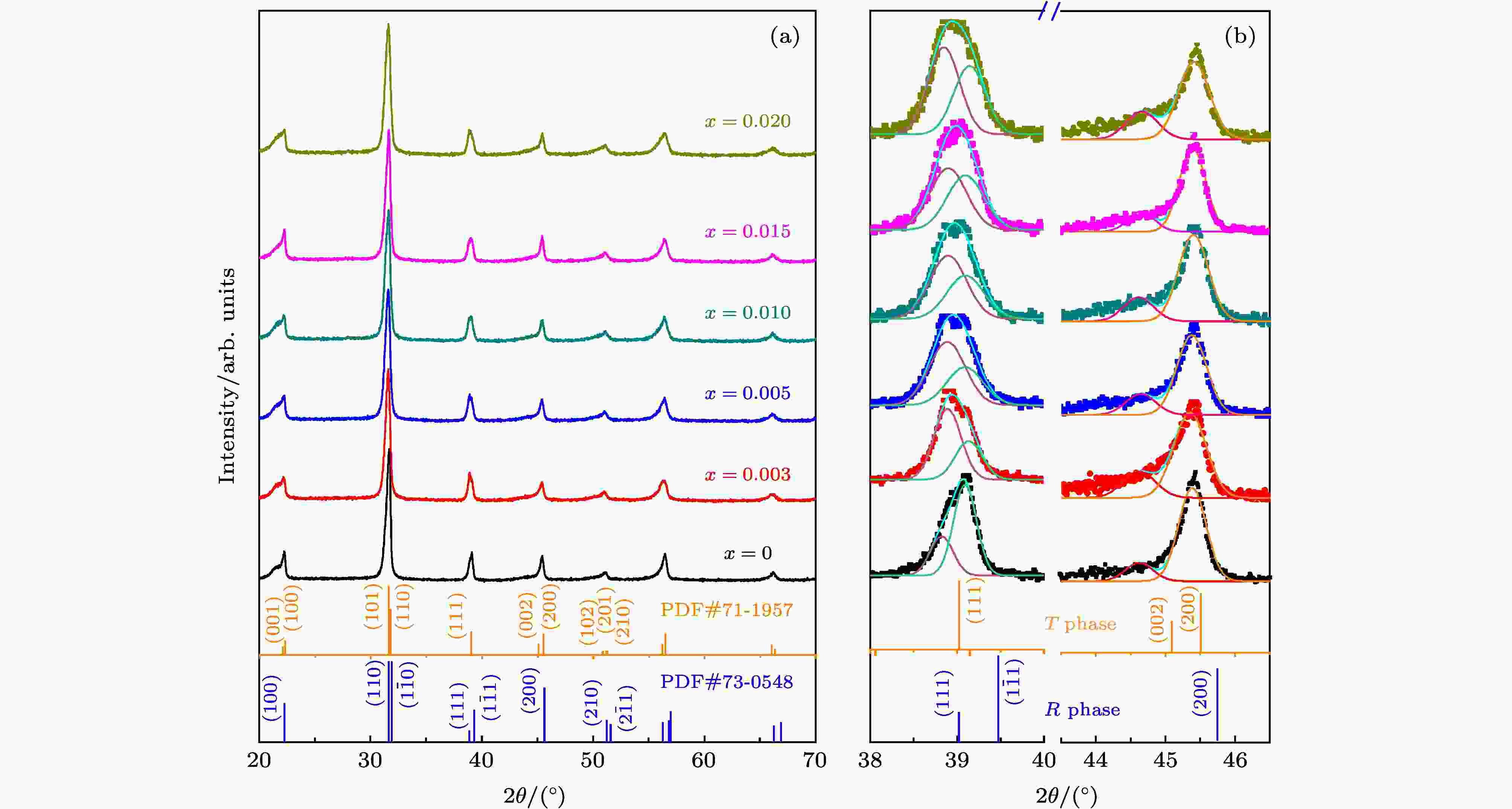
2019, 68 (21): 217701.
doi: 10.7498/aps.68.20190996
Abstract +
Ferroelectrics materials, as a candidate of materials, have recently received attention, for they possess applications in photovoltaic devices and can couple the light absorption with other functional properties. In these materials, the strong inversion symmetry is broken, which is because the spontaneous electric polarization promotes the desirable separation of photo-excited carriers and allows voltages higher than the band-gap, thus permitting efficiency beyond the maximum possible value in a conventional p-n junction solar cell. Much effort has been made to study the ferroelectric photovoltaic effect in several families of ferroelectric perovskite oxides, such as Pb(Zr,Ti)O3, LiNbO3, BaTiO3, KNbO3, Na0.5Bi0.5TiO3-BaTiO3, AgNbO3 and BiFeO3. However, their photo-electric conversion efficiency is now still very low though this field is being studied. The observed output photocurrent is very low due to the negative influence of a wide band-gap and small absorption coefficient, which is caused by the wide band-gaps for most of ferroelectric materials such as Pb(Zr,Ti)O3 (~3.5 eV), and BaTiO3 (~3.3 eV), especially. Although the BiFeO3 system with low band-gap (2.7 eV), which can absorb most visible light for electron transition, is considered as a potential photovoltaic material, it is difficult to synthesize pure perovskite structure. The BiFeO3-BaTiO3 (BF-BT) ferroelectric material with excellent piezoelectric and ferroelectric properties has been widely concerned by researchers in recent years. However, it is still unclear whether this system has the same advantages as BiFeO3 materials with excellent photovoltaic properties. In this work, the Bi(Fe0.96Mg0.02–xTi0.02+x)O3-0.3BaTiO3 ferroelectric ceramics are prepared by the conventional synthesis method to uncover the piezoelectric and ferroelectric properties, as well as the photovoltaic performance with different ratios of Mg2+/Ti4. Because of the electronic production caused by replacing Mg2+ ions with Ti4+ ions, the conductivity of sample increases, and thus its piezoelectric and ferroelectric properties deteriorate. The piezoelectric coefficient d33 decreases from 195 pC/N at x = 0 to 27 pC/N at x = 0.02. Conversely, the range of absorption spectrum increases when the Mg2+ ions are replaced by Ti4+ ions. The band gap of sample decreases from 1.954 eV at x = 0 to 1.800 eV at x = 0.02. The photocurrent of sample increases from 3.71 nA/cm2 at x = 0 to 32.45 nA/cm2 at x = 0.02 because of the combined action of reducing the band gap and internal bias field.
INTERDISCIPLINARY PHYSICS AND RELATED AREAS OF SCIENCE AND TECHNOLOGY

2019, 68 (21): 218101.
doi: 10.7498/aps.68.20190447
Abstract +
Graphene is a two-dimensional (2D) crystal of carbon atoms packed in a honeycomb lattice. Because of this unique structure, it shows a number of intriguing properties. Interface between neighboring 2D layers or between 2D overlayers and substrate surfaces provides confined space for chemical process. The interlayer spacing between bilayer graphenes of van der Waals material is expected to modify the properties of atoms and molecules confined at the atomic interfaces. In this paper, the carbon monoxide (CO) and oxygen (O) in bilayer graphene are studied by density functional theory (DFT). The quantitative relationship between the interlayer spacing of bilayer graphene (d) and the reaction energy barrier ($ {{E_{\rm{a}}}} $ ) is obtained. Five values of d between 4.7 Å and 5.9 Å are used. The calculated results show that the total energy of the initial state, the transition state, the final state system and the reaction barrier are sensitive to the variation of the interlayer distance: the reaction barrier increases gradually with interlayer distance decreasing. The calculated energy barrier is 1.13 eV when the interlayer distance is 4.7 Å, while the energy barrier is 0.39 eV when the interlayer distance is 5.9 Å. It is also found that adsorption energy between O and graphene at the top site and the bridge site increase gradually with interlayer distance decreasing. Therefore, the atomic-level regulation of the reaction barrier can be achieved by changing the interlayer spacing of bilayer graphene. The charge density difference shows that when the distance between two layers of graphene is small, there is an obvious charge accumulation between C atoms in transition state O—C=O and C atoms in the upper or lower layer of graphene. This results in sp orbital hybridization, which leads the interaction between two C atoms to be enhanced. It is difficult to form a weak O—C bond of transition state O—C=O with O atoms adsorbed on graphene because of a binding force which exists in the z-axis direction. The DFT calculation of CO oxidation reaction barrier can be reduced by adjusting the spacing of bilayer graphene, which provides a theoretical support for the application of graphene and the preparation of new carbon-based intercalated composites.

2019, 68 (21): 218501.
doi: 10.7498/aps.68.20190854
Abstract +
The design of the microstructure distribution on the bottom surface of the partial integrated light guide plate (PILGP) is one of the key factors to improve the luminance uniformity of the partial integrated backlight module (BLM). In this paper, the two-dimensional micro-prism expressions on the bottom surface of the small-sized PILGP are presented. The two-dimensional micro-prism expressions make the micro-prisms spread out on a two-dimensional scale of the bottom surface of the PILGP. By fitting and analyzing a large number of simulation data, the relationship expressions between the coefficients of the two-dimensional micro-prism expressions and the structural parameters of the PILGP are established. The above expressions are directly applied to the two-dimensional distribution design of micro-prism on the bottom surface of small-sized PILGPs with different structural parameters. Without the help of the designers’ experience and the multiple simulations of the software, the average value of luminance uniformity in the partial integrated BLMs is obtained to be 84.94%. The simulation results show that the two-dimensional micro-prism expressions and coefficient relation-expressions presented in this paper have important application value. Take the 5-inch partial integrated BLM for example. The two-dimensional distribution of the micro-prism on the bottom surface of the PILGP with high luminance uniformity can be obtained directly by using the above expressions. By fine-tuning the coefficients of two-dimensional micro-prism expressions, calculated by the coefficient relation-expressions, the utilization of light energy, illuminance uniformity and luminance uniformity of the partial integrated BLM respectively reach 90.69%, 88.02% and 92.17%, which meet the practical requirements. The optimization and design time of the partial integrated BLM are both greatly saved. Further, the two-dimensional micro-prism expressions on the bottom surface of the PILGP are analyzed and the physical mechanism is explained reasonably. This work is of significance for the distribution design of the microstructures on the surface of the LGP.

2019, 68 (21): 218701.
doi: 10.7498/aps.68.20190977
Abstract +
GEOPHYSICS, ASTRONOMY, AND ASTROPHYSICS

2019, 68 (21): 219401.
doi: 10.7498/aps.68.20190887
Abstract +
High-frequency sky wave detection equipment must rely on the ionosphere as the propagation medium in the early warning and sea state remote sensing tasks. The ionosphere is time-varying and unstable, which will change the characteristics of the high-frequency electromagnetic wave propagating through it, resulting in the broadening of the echo spectrum, thus seriously affecting the detection of targets and the inversion of sea state parameters. The reason and mechanism of the echo spectrum expansion are analyzed in detail from the dispersion effect, phase contamination and multimode propagation. The bandwidth of the dispersion effect is different from that of the high frequency detection equipment. When the bandwidth of the sky wave equipment is 3–30 MHz, the bandwidths of the dispersion effect are 41.6–57.4 kHz and 0.17–10.8 MHz. The multi-quasi-parabolic ionospheric model is used to discuss the frequency selection measures to avoid multimode propagation. The modulation process of ionospheric contamination to echo is studied theoretically. It is shown that the non-linear phase contamination will cause the energy of echo to diffuse in frequency domain and to be unable to accumulate. To solve the problem of phase contamination which is difficult to solve in practice, a contamination correction method without estimating the instantaneous frequency of the echo is proposed. In the method the consistency principle of signal subspace and signal frequency vector expansion space is used, and therefore the phase contamination term can be well estimated. Based on the real data, the contamination correction results from the proposed method, phase gradient autofocus method, maximum entropy spectral analysis method and time-frequency processing method are given. The results show that the new method is a better method and can effectively sharpen the broadened echo spectrum.

2019, 68 (21): 219701.
doi: 10.7498/aps.68.20191040
Abstract +
Wolf-Rayet stars (WR stars) were discovered by French astronomers Charles Wolf and Georges Rayet in 1867. The Wolf-Rayet (WR) stars are the evolved descents of the most massive, extremely hot (temperatures up to 200000 K) and very luminous (105$ L_{\odot} $ -106$L_{\odot}$ ) O stars, with 25$ M_{\odot} $ -30$M_{\odot}$ solar mass for solar metallicity. The WR stars possess very strong stellar winds, which have velocities up to 3000 km/s and wind mass loss rate $10^{-5} M_{\odot}$ a year. These winds are observed in the broad emission line profiles (sometimes, even P-Cygni profiles) of WR spectra in the optical and UV range. Actually, these winds are so strong that they can peel the star and convert it into a nude nucleus without envelope. It has been found that three bright galactic stars located at Cygnus region have broad strong emission bands, rather than absorptions lines, superposed on the typical continuum of hot stars. In 1930 Beals correctly identified these features as emission lines produced by high ionized elements such as helium, carbon, nitrogen and oxygen. The physical factors which can affect the evolution of WR stars are explored in this paper. These physical factors include stellar mass, initial velocities, orbital periods, metallicities, etc. According to the equations for angular momentum transfer and chemical element diffusion, we can ascertainhow these physical factors influence the evolution of WR stars and the mixing of chemical elements in WR stars.The result indicates that massive stars with high initial velocities and metallicities have strong stellar winds and be prone to producing WR stars. In contrast with the counterpart with high metallicities,it is hard for the single star with low metallicity to generate WR star due to weak wind. However, the star with very high initial velocity and low metallicity can form chemical homogenious evolution. Thestar has an enlarged convective core and a very thin hydrogen envelope and it can also generate WR star. The component in the binary system with short orbital period can transfer mass to the companion star through Roche lobe overflow, and this physical process can produce WR star under the condition of low metallicity. Furthermore, mass removal due to Roche lobe overflow reduces the temperature of stellar convective core and rate of nuclear reaction. It is shown that mass metallicities of chemical elements including 4He, 12C, 19F, 22Ne, 23Na, 25Mg in the primary star are higher than those in the single stars, whereas mass metallicities of chemical elements including 1H, 14N, 16O, 20Ne, and 26Al are lower than those in the single counterparts. In a word, the conditions for massive stars with high initial velocities and metallicities in the binary system with short orbital period favor the formation of WR stars.















